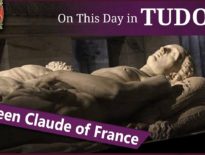On this day in Tudor history, 21st July, 1553, just days after he’d left London with an army to apprehend Mary, half-sister of the late king, Edward VI, John Dudley, Duke of Northumberland was arrested near Cambridge.
But how and why did the man who had ruled England on Edward VI’s behalf, as Lord President of his privy council, come to this?
I explain his role in the accession of Lady Jane Grey as Queen Jane in July 1553 and what happened when Mary overthrew Queen Jane.
Also on this day in Tudor history, 21st July 1545, in the reign of King Henry VIII, French forces landed on the Isle of Wight in an attempt to invade the English island. Find out what happened in last year’s video:
Also on this day in history:
- 1586 – Explorer Thomas Cavendish set sail from Plymouth on his South Sea voyage.
- 1601 – Burial of Peregrine Bertie, 13th Baron Willoughby of Willoughby, Beck and Eresby, at Spilsby Church. Bertie was the son of Katherine Willoughby (married names Brandon and Bertie), Duchess of Suffolk, who married his father, Richard Bertie, as her second husband.
Transcript:
On this day in Tudor history, 21st July, 1553, just days after he’d left London with an army to apprehend Mary, half-sister of the late king, Edward VI, John Dudley, Duke of Northumberland was arrested near Cambridge.
But how and why did the man who had ruled England on Edward VI’s behalf, as Lord President of his privy council, come to this?
Let me explain…
In May 1553, Northumberland’s son, Lord Guildford Dudley, had married Lady Jane Grey, eldest daughter of Henry Grey, Duke of Suffolk, and his wife, Frances Brandon, who was Edward VI’s cousin. When King Edward VI was seriously ill in 1553, he wrote his devise for the succession, his wishes for the succession in the event of his death. Edward loved his half-sisters, Mary and Elizabeth, but did not view them as legitimate claimants as Acts of Parliament had deemed them illegitimate. He looked, instead, to the Grey, choosing for the crown to descend through the male heirs of Frances. However, Frances didn’t have any sons, so when it became clear that Edward was dying, he added “Lady Jane Grey and her heirs male”. Edward VI died on 6th July 1553 and his privy council, led by Northumberland, set about making Jane queen.
On 9th July, Northumberland informed his daughter-in-law of the king’s death and his wishes, and Jane accepted the crown as her duty. It was Northumberland who greeted the new queen and her husband, his son, at the Tower of London on 10th July and made sure that she was proclaimed queen there and around the city.
Unfortunately, nobody at this point had apprehended Mary, who was busy rallying supporters to her cause and preparing to fight for the throne. The privy council chose Jane’s father, the Duke of Suffolk, to go to East Anglia with a force to fetch Mary, but a distraught Jane implored them to send Northumberland instead. Northumberland had reached Cambridge by 15th July and was on his way to Bury St Edmunds to confront Mary’s men when he heard reports of the size of her army, which well outnumbered his own. He decided, therefore, to retreat to Cambridge. What he didn’t know was that Queen Jane’s council, without his strong leadership, had swapped sides and had decided to proclaim for Mary instead. On 19th July 1553, Mary was officially proclaimed Queen Mary I in London.
Northumberland reached Cambridge on 20th July 1553 and there heard news of the privy council’s betrayal and that Mary had been proclaimed queen in Jane’s place. Martyrologist John Foxe shares the eye-witness account of Dr Edwin Sandys, vice chancellor of Cambridge University, regarding what Northumberland did on hearing this bad news.
“The duke that night retired to Cambridge, and sent for Dr. Sands to go with him to the market-place, to proclaim queen Mary. The duke cast up his cap with others, and so laughed, that the tears ran down his cheeks for grief. He told Dr. Sands, that queen Mary was a merciful woman, and that he doubted not thereof; declaring that he had sent unto her to know her pleasure, and looked for a general pardon. Dr. Sands answered, “My life is not dear unto me, neither have I done or said any thing that urgeth my conscience. For that which I spake of the state, hath instructions warranted by the subscription of sixteen counsellors; neither can speech be treason, neither yet have I spoken further than the word of God and the laws of the realm do warrant me, come of me what God will. But be you assured, you shall never escape death; for if she would save you, those that now shall rule, will kill you."
Sandys goes on to say that the guard came that very same night and apprehended Northumberland. The next morning, the Earl of Arundel visited Northumberland, who “fell on his knees” and reminded the earl that he had “done nothing but by the consents of you and all the whole council”. The earl replied that he’d been sent by the queen to arrest him, and arrest him he did.
On 25th July 1553, Northumberland, with his sons, John, Ambrose and Henry, his brother Sir Andrew Dudley, the Earl of Huntingdon, Lord Hastings, and several others were taken to the Tower of London, being greeted in London by a hostile crowd that threw stones at Northumberland and called him “traitor and heretic”. The next day, more prisoners were brought to the Tower, including the Marquis of Northampton and Robert Dudley, another of the duke’s sons.. Of course, his other son, Guildford, consort of the former Queen Jane, was already a prisoner there.
On 18th August 1553, Northumberland was found guilty of treason for his part in putting Lady Jane Grey on the throne. His execution was scheduled for 21st August. However, his execution was cancelled, albeit temporarily, and instead the duke was taken to mass at the Chapel of St Peter ad Vincula, at the Tower, where he recanted his Protestant faith. This was probably more an appeal for mercy and a way of trying to save his sons than a true recantation. It didn’t save the duke, for he was beheaded on Tower Hill the following day, 22nd August 1553, and he was laid to rest next to his predecessor, Edward Seymour, Duke of Somerset. His son, Guildford, was executed in February 1554, on the same day that Lady Jane Grey was executed, but John, Ambrose, Henry and Robert all survived the events of 1553, as did the Marquis of Northampton and the Earl of Huntingdon, and were later released.



Leave a Reply